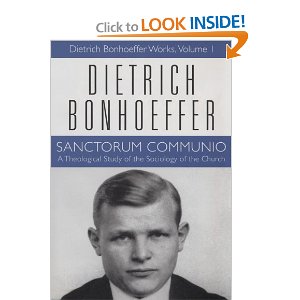Last week I promised I’d begin blogging through Dietrich Bonhoeffer’s major works. I won’t do it every day, as we’ll need a break for lighter subjects. But I’ll resume until finished.
I will refer to Bonhoeffer henceforth as DB.
Some of DB’s works are highly academic. Others are prophetic, written in the context of Nazi Germany.
His academic works are dense and presuppose a fair knowledge of theology, philosophy, and history.
I began this series by starting with DB’s biography, which was the subject of my first post.
The rest of the series is based on the brand new, unabridged translations of his written legacy published in Dietrick Bonhoeffer Works (16 volumes when completed) by Fortress Press.
Let’s explore the first volume today: Sanctorum Communio: A Theological Study of the Sociology of the Church (Dietrich Bonhoeffer Works, Vol. 1)

This was DB’s doctoral dissertation. It is an academic work. It’s considered brilliant and ground-breaking. Years after it was published, Karl Barth called it “a theological miracle.” This work informed all of DB’s work to come. So it was foundational to his life and message.
The explicit goal is to relate sociology with ecclesiology in the description of the Church. DB differentiated his theology both from the Liberalism of his German professors and the new and growing current of Barthian theology (a la, Karl Barth’s view of the Church).
While DB sided with Barth on some of the issues, he differed with him on others.
Ernst Troeltsch exemplified the Liberal approach when he described the Church entirely in terms of secular sociology. Troeltsch was contradicted by Karl Barth, who saw the Church entirely in terms of the response of individuals to God’s act of self-revelation in Christ.
Liberalism fails to maintain the truth of the extraordinary reality that makes the Church what God created her to be in reality. Liberalism reduces the Church to the level of a human religious fellowship. The Church as a spiritual reality is lost.
Barthianism fails also because it reduces the Church to an event that blinks in and out of existence depending on the event of revelation. The Church as a stable, practical reality is also lost.
DB avoids both Liberalism and Barthianism by describing the Church as “Christ existing as community.” And this is the view upheld by Scripture. (See From Eternity to Here for an analysis traced throughout the Biblical narrative.)
It is in the matrix of Christ as community that we become true human beings. We are joined together in the forgiveness of sins. We are gathererd together by the love of God for us and through us in Christ. We are part of Christ together as community under His lordship.
The continuation of the reality of divine revelation is found not in doctrine as such or in pious sentiments. It is found in the reality of the Church. One could paraphrase Bonhoeffer by saying that the real exposition of divine revelation is the Church.
Since the heart of divine revelation is Christ, and Christ is not separate from His Church, this is scripturally true.
Therefore, the Church cannot be reduced to or explained as an empirical community (thus everything that calls itself “Church” isn’t necessarily so). Neither does it exist other than as an empirical community (so DB would reject the postchurch paradigm).
On this basis Bonhoeffer constructs a theology centered on the convergence of Christology and ecclesiology.
What I find amazing is that at the same time that DB penned this insightful Christocentric work on the Church, Watchman Nee was writing along the same lines in China and T. Austin-Sparks was doing the same in England. While DB was a high-church Lutheran, his theology of the Church was fundamentally the same as theirs.
Here are some excerpts:
“Christ personifies the new humanity, and the Christian community is about the restoration and consummation of the created sociality of humanity.”
“Paul repeatedly identifies Christ and the church-community. Where the body of Christ is, there Christ truly is. Christ is in the church-community, as the church-community is in Christ. To be in Christ is synonymous with to be in the church-community.”
“The church is the presence of Christ the same way that Christ is the presence of God.”
“In and through Christ the church is established in reality. It is not as if Christ could be abstracted from the church; rather, it is none other than Christ who is the church.”
My favorite part by far is Chapter 5. For an academic book on the reality of Christ and the Church, this is a priceless work.
Click here to order from Amazon at a discount


Studied DB the last 3 months. Looking forward to read your take on him.
I spent the last 2 hours reading your posts. And I must say: awesome site!
Frank,
Looking forward to this series of blogs.
Through the years I’ve been constantly drawn back to Life Together.
Thomas Merton studied DB extensively and recorded some observations in Conjectures of a Guilty Bystander
Great post, just posted a link to it on my blog and tweeted it as well …. thanks Frank for a challenging and thought provoking post. Looking forward to the rest.
“Sanctorum Communio” is some tough reading, but great stuff for sure.
Frank,
Thanks for sharing and this is a good summary of DB’s foundation for his theology. Looking forward to future posts.